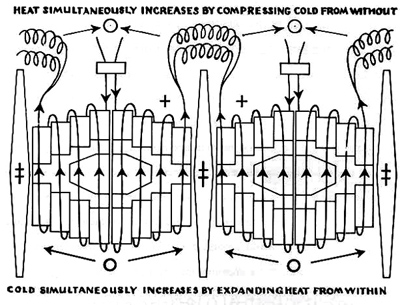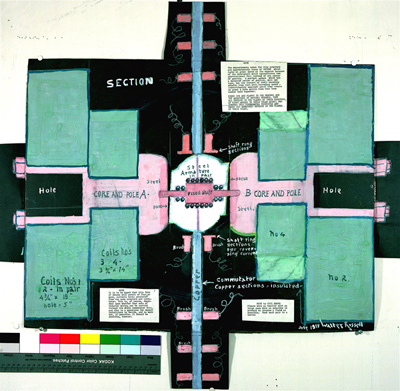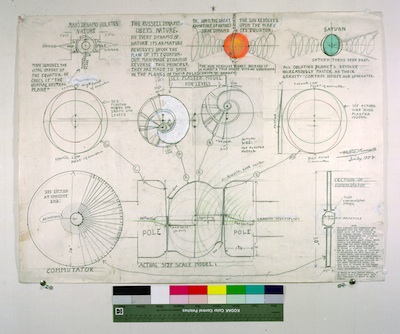The third drawing [see Figure 1.1.1 below] refers to "plaster casts" of these internal Armature patterns. Of course that was in 1958. Do these casts still exist? These plaster castings would guide us in a proper direction, if they exist.
Our current thinking is until and unless more information is obtained this project is on indefinite hold. Current understandings do not warrant the considerable investment of time and money into replicating this device. However, one could conceivably replicate the coils to study out their form and function. As also the form and function of the central copper disk which reminds me of the Testatika spinning disk which itself is not unlike a Wimhurst disk or Homopolar Motor. Dale PondThese three below drawings are to be referenced throughout this wiki page:

Russell Optic Dynamo-Generator - Figure 1.0 (courtesy University of Science and Philosophy) (click to enlarge) |

Russell Optic Dynamo-Generator - Figure 1.1 (courtesy University of Science and Philosophy) (click to enlarge) |

Russell Optic Dynamo-Generator - Figure 1.1.1 (courtesy University of Science and Philosophy) (click to enlarge) |
In this section the actual physical design and construction of the Optic Dynamo-Generator will be explored, part by part and function by function. This page covers mechanical design, parts and sub-systems. The function, laws and principles of the dynamics in this device have been exposed in Polar Interchange - Parts I-IV.
The Figures 1.1 and 1.1.1 are marked 1958 making it an earlier drawing than the notes we have dated 1961. Accordingly, these drawings are not a working design. Russell began with these to make his constructions in 1961 and subsequently modified several times. We do not have drawings of the 1961 fabrications and modifications. We do have some of the notes. So we begin with what we have in hand....
OBSERVATIONS 1 - It is believed (as of March 06, 2013) this design resembles a shorted armature that creates its own field. This dynamic may play a significant role or maybe not at all. 2- Because the Steel Armature has a divided center of mass/gravity it is assumed any fields are "pulsed" along the Commutator Disk and picked up by the brushes.
The device is built in two mirror sections as though they represent two vortices intermingled. Each side of the device mirrors the other side as a mated pair. These two mirror sections are marked "A" on the left and "B" on the right. Parts are labeled below with and "A" or "B" indicating which side of the device.
NOTES - on Figure 1.1 Upper Right
- The measurements taken for this armature are approximately those of SATURN which turns at great speed at its equator because of its oblateness which necessitates two gravitational foci instead of one center of gravity. A perfect sphere which has a balanced center of gravity, will not turn, but the instart [sic?] of their becoming oblater they turn with increasing speed - (centrifugally exerted) until they create so great a hole within them that they cannot hold together.
- EVERY SUN AND PLANET IN THE HEAVENS ARE THE ARMATURES OF NATURE'S DYNAMOS. THEY ALL REVOLVE IN THE PLANES OF THEIR EQUATORS, AT RIGHT ANGLES TO THEIR POLAR AXIES. MAN IGNORES THIS FUNDAMENTAL PRINCIPLE AND MAKES HIS ARMATURES REVOLVE IN THE PLANES OF THEIR POLES. (underline added to contrast ideas) [see We Now Build the Nine Equators of Cube-Sphere Wave-Fields]
Lower Right
- NOTE to COIL MAKER
- Please wire as heavily with as large gage [gauge] wire as possible to produce as intense a [magnetic] field as possible. Hook each pair in a series
Lower Left
- It is to be hoped that this form of dynamo will permit of four, or more, currents being generated from the same armature and commutator. This is, of course, dependent upon whether four sets of inductor wiring can be carried through the whole commutator disk, and that is a questions for expert technicians to decide, and to work out, it possible. It should be possible, however.
NOTES - on Figure 1.1.1 Lower Right
- This armature and commutator was designed with the hope that we could carry off four circuits on this present design, instead of only one. Eventually ten circuits should be carried off. If the commutator split shaft rings, which reverse the current, are too far away from the shaft center, as now designed, which makes the shaft 11 inches in diameter instead of two or three, it might me [be] necessary to elliminate [eliminate] the ball bearings on the fixed shaft, and actually carry the whole armature on small shaft. The commutator rings could then be made in four sets and attached to the shaft inside the coils. The four sets of brushes on the copper disc could then be connected with their corresponding pair.
- It would be much better though, if we could have a fixed shaft with ball bearings. It would be more simple.
Coils
| Coil | Wire Gage | Length | ID | OD |
Coil #1A | ? | ? | ? | ? |
Coil #2A | ? | ? | ? | ? |
Coil #3A | ? | ? | ? | ? |
Coil #4A | ? | ? | ? | ? |
Coil #1B | ? | ? | ? | ? |
Coil #2B | ? | ? | ? | ? |
Coil #3B | ? | ? | ? | ? |
Coil #4B | ? | ? | ? | ? |
This video shows layered coils vastly increasing their power.
Commutator - large copper disk in the center
- Marked "COPPER"
- Note on drawing - Commutator, copper sections - insulated
- 30" diameter on Figure 1.1.1
- 2" thick on Figure 1.1.1
Core and Pole marked made of steel
- 6" OD Figure 1.1.1
- A Core and Pole - left core and pole
- B Core and Pole - right core and pole
Steel Armature - two offset centers of gravity on Figure 1.1.1. Or is it two offset centers of mass?
- 6" diameter on Figure 1.1.1
- A Half
- B Half
This quote may be a clue to the design of the Armature Core: "It is common knowledge that a coil of wire carrying many turns will step energy up or down according to the direction of the current. Imagine a spherical volume of energy, cut through the middle as an orange is halved. If you could see the electric spiral turns, they would look like a spiral vortex of many wires, close together and well defined near the center until lost suddenly in what one calls a solid. In this they become apparently fused. The outer ends of the spiral are very broad hands of increasingly foggy indefiniteness. If one could see such an effect one could understand Nature's solenoid principle of stepping energy up and down." Genero-Radiative Concept - Part 4
Fixed Shaft
Shaft Ring Sections
- Note on drawing - Shaft Ring Sections for reversing current
Brushes - Locked Potential (Indig) Positions/Numbers "t" = TOP of drawing "b" = BOTTOM of drawing
| Brush | Size | Leads to | ||
Brush 1At | ? | ? | ||
Brush 2At | ? | ? | ||
Brush 3At | ? | ? | ||
Brush 4At | ? | ? | ||
Brush 1Ab | ? | ? | ||
Brush 2Ab | ? | ? | ||
Brush 3Ab | ? | ? | ||
Brush 4Ab | ? | ? | ||
Brush 1Bt | ? | ? | ||
Brush 2Bt | ? | ? | ||
Brush 3Bt | ? | ? | ||
Brush 4Bt | ? | ? | ||
Brush 1Bb | ? | ? | ||
Brush 2Bb | ? | ? | ||
Brush 3Bb | ? | ? | ||
Brush 4Bb | ? | ? | ||
NOTES & Observations:
- The armature has two centers of mass or centers of gravity.
- Each armature half has an offset center of mass or gravity. The are not symmetrical within themselves but are symmetrical when placed face to face.
- The armature appears to be made of copper to convert magnetic fields into electricity.
- The copper disk functions not unlike a Homopolar Motor or Wimhurst disk.
- The two opposing magnetic fields are PARALLEL to the shaft, not perpendicular to it.
